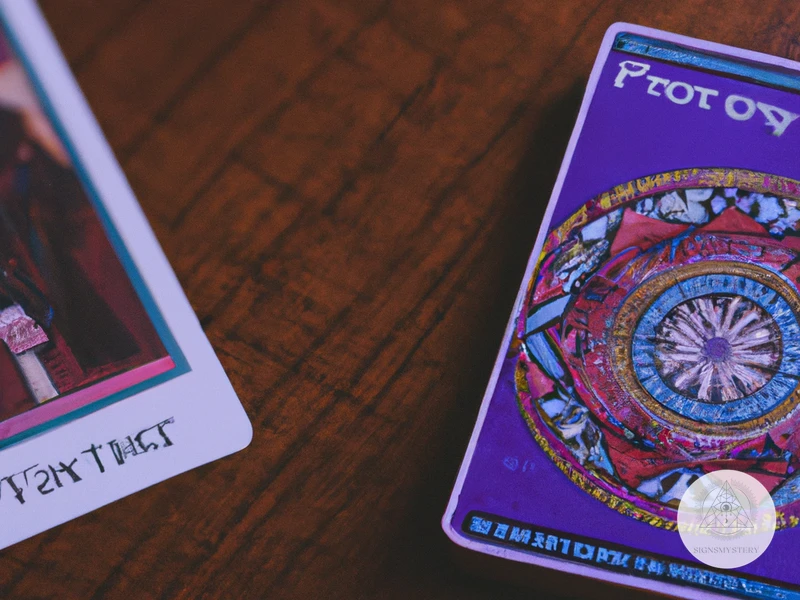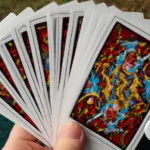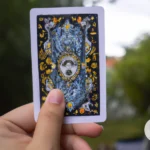Have you ever been curious about how Tarot and Psychology can intersect? Despite their seemingly different natures, the two can be combined to create an introspective and transformative experience. Tarot cards have been used for centuries as a tool for divination and guidance. Meanwhile, Psychology explores the depths of the human mind and behavior. This article will delve into the connection between Tarot and Psychology – how Tarot can affect Psychology and the benefits of using Tarot for self-discovery. Get ready to explore the world of Tarot and deepen your understanding of yourself!
The Connection between Tarot and Psychology

Tarot has long been associated with mystical and supernatural practices, but the connection between tarot and psychology may surprise you. At their core, both tarot and psychology are deeply interested in self-discovery and understanding the human experience. In tarot, the cards serve as a tool for accessing your intuition and inner wisdom, while in psychology, therapy and counseling are used to explore and process your emotions and thought patterns. By using tarot as a means of self-reflection, it can help you gain insight into your psyche and provide guidance for personal growth. Tarot can also be incorporated into therapy to deepen the exploration process, making it a powerful addition to traditional therapy modalities.
How Tarot Affects Psychology
Tarot affects psychology in several ways. Here are some of them:
| Way Tarot Affects Psychology | Description |
|---|---|
| Increased self-awareness | Tarot cards can help you tap into your subconscious and uncover things about yourself you may not have been aware of before. This can lead to greater self-understanding and acceptance. |
| Reduced anxiety and stress | By providing insight and guidance, tarot cards can help alleviate fears and anxieties. |
| Improved decision making | When used properly, tarot cards can help you clarify your thoughts and feelings, leading to more informed and thoughtful decisions. |
| Emotional healing | Tarot cards can help you process emotions and work through difficult experiences, providing a release and a way to move forward. |
It is important to note that tarot is not a substitute for professional therapy, but rather a tool that can complement therapy and other self-care practices. Additionally, it is important to approach tarot with an open mind and a willingness to engage in self-reflection.
If you are new to tarot, you may want to consider developing your intuition and learning how to read tarot cards yourself. Other helpful resources include learning about different spreads and asking the right questions, understanding the importance of card reversals, and exploring the concept of synchronicity and the multiple meanings of each card.
Benefits of Using Tarot for Self-Discovery
Using Tarot for self-discovery has numerous benefits for individuals seeking introspection and self-improvement. Here are some of the key benefits:
1. Gain Clarity: Tarot readings often provide insights that bring clarity to your thoughts and emotions. It can help you navigate your problems and give you a different perspective on your current situation.
2. Self-Reflection: Tarot can be a tool for self-reflection. It encourages you to look inward, reflect on your experiences and emotions, and gain a deeper understanding of yourself.
3. Develop Intuition: Through frequent use of Tarot, you can develop your intuition, which can be a valuable tool for making better decisions and creating positive changes in your life.
4. Improve Decision Making: Tarot can assist you in making wise decisions by offering insights into your situation. The insights gained from Tarot can lead to better options and encourage rational decisions.
5. Self-Care: Practicing Tarot can be a self-care act in itself. It is an opportunity to set aside time for yourself and focus solely on your well-being.
Using Tarot as a tool for self-discovery can be a transformative experience. By gaining deeper insights into your inner-self, and practicing self-care, you can develop a greater understanding of who you are, make better decisions in your life, and create a more fulfilling existence.
How to Use Tarot for Personal Growth
If you’re interested in using tarot for personal growth, there are several steps you can take to get started. First, set a clear intention for the reading, which can help you focus on a specific area of your life or a particular question you have. Next, choose a deck that resonates with you and your goals. Consider the imagery and symbolism used in the cards, as well as the overall vibe of the deck. Once you have your deck, it’s time to shuffle and draw cards. Trust your intuition as you select the cards, as they may have insights and messages for you. Finally, carefully study and interpret the cards. Tarot can offer valuable insights into your psyche and inner thoughts, helping you gain new perspectives and insights about yourself and your life. Remember to approach the process with an open mind and a willingness to reflect on your experiences.
Setting the Intention
Setting the intention is one of the most important steps when using the Tarot for personal growth and self-discovery. Before starting a reading, it is essential to set a clear intention for what you want to gain from the experience. This helps to focus your mind and ensure that the cards reveal insights that are relevant and meaningful to your life.
To set the intention, begin by asking yourself what you hope to achieve from the reading. Are you looking for guidance on a specific issue, seeking clarity on a decision, or simply exploring your feelings on a particular topic? Take some time to reflect on your thoughts and feelings, and write down your intention in a journal or on a piece of paper.
Remember that the intention should be positive, specific, and focused on what you want to achieve. Avoid setting negative intentions or asking questions that focus on what you don’t want to happen. Instead, phrase your intention in a way that inspires and motivates you towards positive change.
Once you have set your intention, take a few deep breaths and visualize yourself achieving your goal. Imagine what it would feel like to have the clarity and insights that you seek. This helps to align your energy with your intention and opens you up to receiving the guidance and insights that the Tarot can provide.
Keep in mind that the intention is a powerful tool that can help you to manifest positive change in your life. By setting a clear intention before your reading, you are taking the first step towards creating a brighter and more empowered future for yourself.
Choosing the Right Deck
When it comes to choosing the right deck for your Tarot practice, there are a few factors to consider. Firstly, it’s important to note that there are many different Tarot decks available, each with their own unique imagery and symbolism. Some of the most commonly used decks include the Rider-Waite-Smith deck, the Thoth deck, and the Marseille deck.
One factor to consider when choosing a deck is the level of familiarity you have with the imagery and symbolism. If you are new to Tarot, it may be helpful to choose a deck that follows the traditional Rider-Waite-Smith structure, as many other decks are based on this template and it can be a good foundation for learning.
However, if you have a particular interest in a certain theme or tradition, such as astrology or Wicca, you may want to choose a deck that reflects those interests. There are also decks that cater specifically to queer or feminist perspectives, or that use non-traditional imagery.
Another factor to consider is the artwork and visual style of the deck. Tarot is a visual medium, and you want to choose a deck that resonates with you aesthetically. Do you prefer more realistic or abstract artwork? Do you like brighter or darker colors? There are many different options available, so take some time to explore and see which decks catch your eye.
Finally, it can be helpful to read reviews or seek recommendations from others who practice Tarot. They may have insights into particular decks that they find particularly useful or inspiring. Remember that ultimately, the deck you choose should feel like a good fit for you and your practice.
Shuffling and Drawing Cards
After setting the intention and choosing the right tarot deck, it’s time to shuffle and draw the cards. Shuffling is a crucial aspect of tarot reading because it is believed to infuse the deck with your energy and intentions. There are several ways to shuffle tarot cards, and you can choose the method that feels most comfortable to you.
One common method of shuffling tarot cards is the traditional riffle shuffle. To do this, hold the deck with your non-dominant hand and use your other hand to split it in half. Then, use your thumbs to riffle through the cards so they overlap, letting them fall back together. Repeat this several times or until you feel satisfied that the energy is infused into the cards.
Another method of shuffling is the overhand shuffle, where you hold the deck in one hand and use the other to take small stacks of cards and place them on top of each other. This method is often gentler on the cards than the riffle shuffle, making it a good option for beginners or those with delicate decks.
Once you’ve shuffled the cards, it’s time to draw them. There are different ways to draw tarot cards, such as drawing a single card or multiple cards for a spread. To draw a single tarot card, hold the deck in your non-dominant hand and use your dominant hand to draw the top card. This card will represent the energy or message that is most relevant to your question or intention.
If you are doing a tarot spread, you can choose to draw the cards in a specific order or let them fall out randomly. One common spread is the three-card spread, where the first card represents the past, the second card represents the present, and the third card represents the future. Another popular spread is the Celtic Cross, which involves ten cards to provide a more in-depth analysis of the situation.
Remember to take your time when shuffling and drawing cards, allowing yourself to focus on your intention and the energy surrounding the cards. Don’t rush the process and trust that the cards you draw hold valuable insights and messages for your self-discovery journey.
Interpreting Cards
Interpreting cards is the most crucial step in using tarot for self-discovery. Once you have shuffled and drawn your cards, you need to interpret them. Many tarot readers often feel perplexed at this stage, which is entirely understandable. But remember, interpretation is subjective, and there is no right or wrong answer.
To interpret cards effectively, you need to lay them out in a specific pattern called a spread. A spread is a predetermined layout of cards that helps you understand the messages and the overall theme. Some popular spreads include the Celtic cross, the three-card spread, and the past-present-future spread.
Once you have laid out your cards according to the spread, take a moment to look at each card carefully. Notice the symbols, colors, and figures depicted on each card. They all hold significant meanings that are unique to individual decks, so it’s crucial to reference the guidebook that came with your deck.
Start by interpreting each card individually, trying to connect the symbols to your question. Then, look at the cards as a whole, considering how they interact with one another to create a picture. Some cards might complement each other, while others might oppose each other.
It’s essential to take note of your immediate reactions to the cards as well. You might have a particular feeling or thought that comes up when you look at a card. These reactions are significant because they offer further clues to the interpreting process. Once you’ve interpreted each card, reflect on the answer as a whole. What message is your intuition telling you?
Remember, interpreting cards is a skill that takes time and practice. Be patient with yourself and keep an open mind. Tarot is not about predicting the future, but rather a tool for self-discovery and reflection. Keep your interpretation focused on the present moment, and use the messages from the cards to guide you towards your desired outcome.
Incorporating Tarot into Therapy
Subscribe to Our Newsletter
Sign up to receive the latest news and updates.










